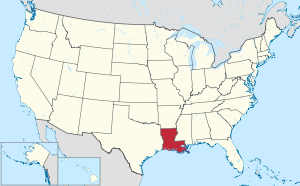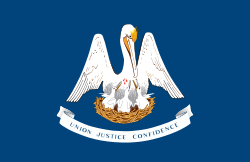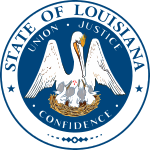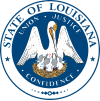
Back Louisiana Afrikaans ሉዊዚያና Amharic Loisiana AN Hloðwigeanne ANG لويزيانا Arabic لويزيانا ARY لويزيانا ARZ Louisiana AST Louisiana suyu Aymara Luiziana Azerbaijani
Louisiana
| |
|---|---|
| State of Louisiana État de Louisiane (French) Estado de Luisiana (Spanish) Létat de Lalwizyàn (Louisiana Creole) | |
Nicknames:
| |
| Motto(s): Union, Justice, Confidence | |
Anthem:
| |
 Location of Louisiana within the United States | |
| Country | United States |
| Before statehood | Territory of Orleans and Louisiana Purchase |
| Admitted to the Union | April 30, 1812 (18th) |
| Capital | Baton Rouge |
| Largest city | New Orleans[1][2][3] |
| Largest county or equivalent | East Baton Rouge Parish |
| Largest metro and urban areas | Greater New Orleans |
| Government | |
| • Governor | Jeff Landry (R) |
| • Lieutenant Governor | Billy Nungesser (R) |
| Legislature | Legislature |
| • Upper house | Senate |
| • Lower house | House of Representatives |
| Judiciary | Louisiana Supreme Court |
| U.S. senators | Bill Cassidy (R) John Kennedy (R) |
| U.S. House delegation | 4 Republicans 2 Democrats (list) |
| Area | |
• Total | 52,124[4][5] sq mi (135,000 km2) |
| • Land | 43,204 sq mi (111,898 km2) |
| • Water | 8,920 sq mi (23,102 km2) 15% |
| • Rank | 31st |
| Dimensions | |
| • Length | 379 mi (610 km) |
| • Width | 130 mi (231 km) |
| Elevation | 100 ft (30 m) |
| Highest elevation | 535 ft (163 m) |
| Lowest elevation | −8 ft (−2.5 m) |
| Population (2024) | |
• Total | |
| • Rank | 25th |
| • Density | 106.9/sq mi (41.3/km2) |
| • Rank | 26th |
| • Median household income | $58,200 (2023)[8] |
| • Income rank | 47th |
| Demonyms | Louisianian Louisianais (Cajun or Creole heritage) Luisiano (Spanish descendants during rule of New Spain) |
| Language | |
| • Official language | None constitutionally specified; Louisiana French (special status under CODOFIL) |
| • Spoken language | As of 2010[9] |
| Time zone | UTC−06:00 (CST) |
| • Summer (DST) | UTC−05:00 (CDT) |
| USPS abbreviation | LA |
| ISO 3166 code | US-LA |
| Traditional abbreviation | La. |
| Latitude | 28° 56′ N to 33° 01′ N |
| Longitude | 88° 49′ W to 94° 03′ W |
| Website | louisiana |
| List of state symbols | |
|---|---|
 | |
 | |
| Living insignia | |
| Bird | Brown pelican |
| Dog breed | Catahoula Leopard Dog |
| Fish | Crappie |
| Flower | Magnolia |
| Insect | Honeybee |
| Mammal | Black bear |
| Reptile | Alligator |
| Tree | Bald cypress |
| Inanimate insignia | |
| Beverage | Milk |
| Fossil | Petrified palmwood |
| Gemstone | Agate |
| Instrument | Diatonic accordion |
| State route marker | |
 | |
| State quarter | |
 Released in 2002 | |
| Lists of United States state symbols | |

Louisiana[pronunciation 1] (French: Louisiane [lwizjan] ⓘ; Spanish: Luisiana [lwiˈsjana]; Louisiana Creole: Lwizyàn)[b] is a state in the Deep South and South Central regions of the United States. It borders Texas to the west, Arkansas to the north, and Mississippi to the east. Of the 50 U.S. states, it ranks 31st in area and 25th in population, with roughly 4.6 million residents. Reflecting its French heritage, Louisiana is the only U.S. state with political subdivisions termed parishes, which are equivalent to counties, making it one of only two U.S. states not subdivided into counties (the other being Alaska and its boroughs). Baton Rouge is the state's capital, and New Orleans, a French Louisiana region, is its largest city with a population of about 383,000 people.[12] Louisiana has a coastline with the Gulf of Mexico to the south; a large part of its eastern boundary is demarcated by the Mississippi River.
Much of Louisiana's lands were formed from sediment washed down the Mississippi River, leaving enormous deltas and vast areas of coastal marsh and swamp.[13] These contain a rich southern biota, including birds such as ibises and egrets, many species of tree frogs—such as the state-recognized American green tree frog—and fish such as sturgeon and paddlefish. More elevated areas, particularly in the north, contain a wide variety of ecosystems such as tallgrass prairie, longleaf pine forest and wet savannas; these support an exceptionally large number of plant species, including many species of terrestrial orchids and carnivorous plants. Over half the state is forested.
Louisiana is situated at the confluence of the Mississippi river system and the Gulf of Mexico. Its location and biodiversity attracted various indigenous groups thousands of years before Europeans arrived in the 17th century. Louisiana has eighteen Native American tribes—the most of any southern state—of which four are federally recognized and ten are state-recognized.[14] The French claimed the territory in 1682, and it became the political, commercial, and population center of the larger colony of New France. From 1762 to 1801 Louisiana was under Spanish rule, briefly returning to French rule before being sold by Napoleon to the U.S. in 1803. It was admitted to the Union in 1812 as the 18th state. Following statehood, Louisiana saw an influx of settlers from the eastern U.S. as well as immigrants from the West Indies, Germany, and Ireland. It experienced an agricultural boom, particularly in cotton and sugarcane, which were cultivated primarily by slaves from Africa. As a slave state, Louisiana was one of the original seven members of the Confederate States of America during the American Civil War.
Louisiana's unique French heritage is reflected in its toponyms, dialects, culture, demographics, and legal system. Relative to the rest of the southern U.S., Louisiana is multilingual and multicultural, reflecting an admixture of Louisiana French (Cajun, Creole), Spanish, French Canadian, Acadian, Saint-Domingue Creole, Native American, and West African cultures (generally the descendants of slaves stolen in the 18th century); more recent migrants include Filipinos and Vietnamese. In the post–Civil War environment, Anglo-Americans increased the pressure for Anglicization, and in 1921, English was shortly made the sole language of instruction in Louisiana schools before a policy of multilingualism was revived in 1974.[15][16] Louisiana has never had an official language, and the state constitution enumerates "the right of the people to preserve, foster, and promote their respective historic, linguistic, and cultural origins."[15]
Based on national averages, Louisiana frequently ranks low among U.S. states in terms of health,[17] education,[18][19][20][21] and development, with high rates of poverty[22][23][24] and homicide. In 2018, Louisiana was ranked as the least healthy state in the country, with high levels of drug-related deaths. It also has had the highest homicide rate in the United States since at least the 1990s.[25][26][27]
- ^ "New Orleans a 'ghost town' after thousands flee Gustav: mayor", AFP, August 31, 2008, archived from the original on May 16, 2013
- ^ "Expert: N.O. population at 273,000". WWL-TV. August 7, 2007. Archived from the original on September 26, 2007. Retrieved August 14, 2007.
- ^ "Relocation". Baton rouge. Connecting U.S. Cities. May 3, 2007. Archived from the original on February 9, 2014.
- ^ "State Area Measurements and Internal Point Coordinates". The United States Census Bureau. Archived from the original on April 7, 2020. Retrieved August 14, 2023.
- ^ "Median Household Income in Louisiana". Federal Reserve Bank of St. Louis. Archived from the original on September 21, 2019. Retrieved October 9, 2019.
- ^ a b "Elevations and Distances in the United States". United States Geological Survey. 2001. Archived from the original on October 15, 2011. Retrieved October 21, 2011.
- ^ "United States Census Quick Facts Louisiana". Retrieved January 9, 2025.
- ^ "Household Income in States and Metropolitan Areas: 2023" (PDF). Retrieved January 12, 2025.
- ^ "United States". Modern Language Association. Archived from the original on December 1, 2007. Retrieved June 14, 2017.
- ^ "Louisiana". Merriam-Webster.com Dictionary. Merriam-Webster.
- ^ "Louisiana Creole (Kouri-Vini) Dictionary » Lwizyann". Archived from the original on February 1, 2024. Retrieved February 1, 2024.
- ^ Jessica Williams. (12 December 2021). "Census 2020: Who lives in the New Orleans metro now? Data show more diverse population". nola.com website Archived December 9, 2022, at the Wayback Machine Retrieved 8 December 2022.
- ^ "Louisiana (LA) State Information". The Time Now. August 3, 2015. Archived from the original on August 13, 2020. Retrieved December 23, 2020.
- ^ "Louisiana Indians in the 21st Century" Archived December 23, 2017, at the Wayback Machine, Louisiana Folklife Program, 2013
- ^ a b Louisiana Official Site on Languages Archived June 21, 2015, at the Wayback Machine, accessed August 22, 2016
- ^ Murphy, Alexander B. (2008). "Placing Louisiana in the Francophone World: Opportunities and Challenges" (PDF). Atlantic Studies. 5 (3): 11. doi:10.1080/14788810802445040. ISSN 1478-8810. S2CID 45544109. Archived from the original (PDF) on May 10, 2013. Retrieved April 23, 2014.
- ^ Woodruff, Emily (April 8, 2021). "Why is Louisiana unhealthy? New state database aims to connect environment, behavior to health". NOLA.com. Archived from the original on June 7, 2021. Retrieved June 7, 2021.
- ^ "Louisiana Educational attainment – persons 25 years and over – percent high school graduate or higher by County". www.indexmundi.com. Archived from the original on June 7, 2021. Retrieved June 7, 2021.
- ^ "United States – Educational attainment – persons 25 years and over – percent high school graduate or higher by State". www.indexmundi.com. Archived from the original on June 7, 2021. Retrieved June 7, 2021.
- ^ McElfresh, Amanda. "Report: Louisiana is one of the least-educated states in the nation". The Daily Advertiser. Archived from the original on June 7, 2021. Retrieved June 7, 2021.
- ^ Hutchinson, Piper (February 14, 2023). "Report: Louisiana third least educated state in nation". KPLC-TV. Archived from the original on February 16, 2023. Retrieved February 16, 2023.
- ^ "State Median Household Income Patterns: 1990–2010". U.S. Census Bureau. Archived from the original on August 12, 2012. Retrieved August 6, 2012.
- ^ "Sub-national HDI—Subnational HDI—Global Data Lab". globaldatalab.org. Archived from the original on September 15, 2019. Retrieved May 24, 2019.
- ^ "Census: Louisiana remains 1 of nation's poorest states". AP News. September 27, 2019. Archived from the original on June 7, 2021. Retrieved June 7, 2021.
- ^ "Louisiana Annual State Health Rankings—2018". America's Health Rankings. Archived from the original on December 1, 2014. Retrieved October 5, 2014.
- ^ Murder Rates Nationally and By State Archived May 28, 2019, at the Wayback Machine. By Death Penalty Information Center.
- ^ "Crime in the United States by State, 2014". Archived from the original on June 28, 2016. Retrieved November 5, 2019.
Cite error: There are <ref group=lower-alpha> tags or {{efn}} templates on this page, but the references will not show without a {{reflist|group=lower-alpha}} template or {{notelist}} template (see the help page).
Cite error: There are <ref group=pronunciation> tags on this page, but the references will not show without a {{reflist|group=pronunciation}} template (see the help page).

